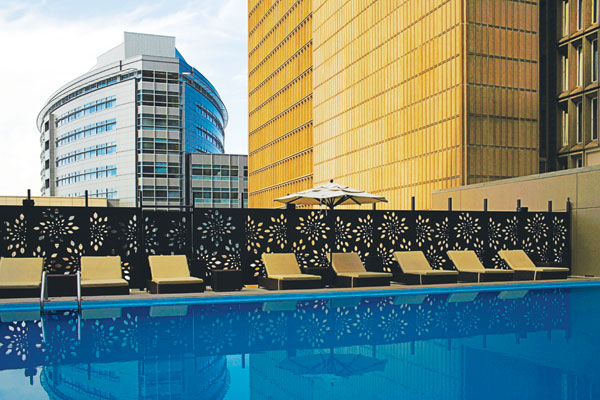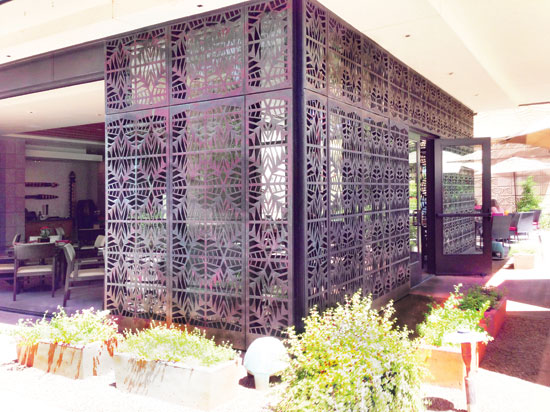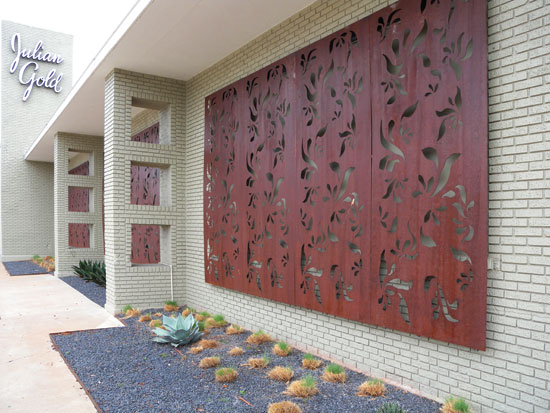Pattern Mapping for Lasting Design
Using Patterns in Space
This innate awareness of and affinity for patterns make them a powerful tool for architects to help people make sense of and navigate a space. Patterns can be used to highlight how a space is organized. They can hide unattractive aspects of a project, provide privacy, or enhance the architectural identity of a building. Patterns can even be used to provide shading and make exterior spaces more comfortable throughout the day, while creating an interactive experience of art in shadow.
Help Occupants Understand the Space
Materials that prominently feature a pattern can successfully garner the attention of an occupant, regardless of whether the pattern is visible in the central field of vision or on the periphery. This predisposition to recognize patterns can be used to help occupants identify security railings and paths of egress and help them understand how a larger space is organized or partitioned into smaller segments.

Photo courtesy of Parasoleil
Architectural panels with patterned openings were used to provide a pool security screen and to hide rooftop air condensers for the Denver Downtown Sheraton Hotel. Architect: Leo A. Daly
Create Privacy or Hide Eyesores
Patterned materials, although not opaque, offer effective visual barriers in spaces, creating privacy or effectively hiding trash cans or mechanical devices. This is due, in part, to the physiological function of the human eye. As previously discussed, the eye is naturally drawn to patterns and the eye is only capable of focusing on one item at a time. If the eye is focused on the patterned panel, it cannot simultaneously focus on the items behind the patterned panel.
Provide Shading
The open nature of the physical pattern creates an opportunity to use patterned panels as a shading mechanism that will allow some of the sun's rays to pass through the open areas, while providing a significant degree of shade and allowing airflow to circulate effectively. It should be noted that a patterned panel used to provide shade also offers occupants a unique interaction with shadow and the dynamic nature of sunlight as the sun progresses along its daily path.
Enhance or Modify Architectural Identity
Patterns can also be used to update the physical structure of a building in a few different ways. Applying a pattern to the façade of a building, or to skin an interior wall, can enhance the existing lines in newer, more modern materials or add contrasting elements to repurpose a structure and breathe new life into an older, utilitarian design. Patterns can also be used to create new walls or partitioning surfaces that can expand or modify the footprint of the original space.


Photos courtesy of Parasoleil
Use patterned architectural panels to update an existing façade or to camouflage structural supports.
Historical Uses of Patterns
Historically, patterns have been incorporated into art and architecture for a number of reasons. For purely aesthetic benefit, patterns have been hand-carved into stone and marble edifices, painted on solid surfaces, and woven into textiles for interior or exterior display. For centuries, Middle Eastern architecture has featured an intricately patterned wood or copper screen, called mashrabiya, that is placed over windows and building façades to provide shade and to help dissipate the incredible solar heat gain that can occur in that desert region. Delicate patterned screens adorned Catholic confessionals, providing beauty, separation, and concealment of identity from one side to the other, but allowing conversation and the confession to flow easily through the perforations. Creating these beautiful and functional patterned structures and materials was time consuming, but the prevalence of pattern found throughout history indicates that the aesthetic improvement was considered worth the effort.









